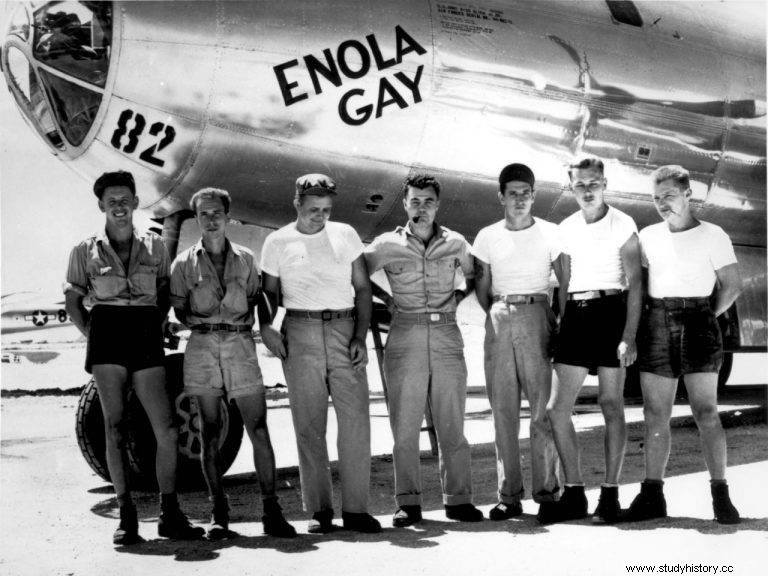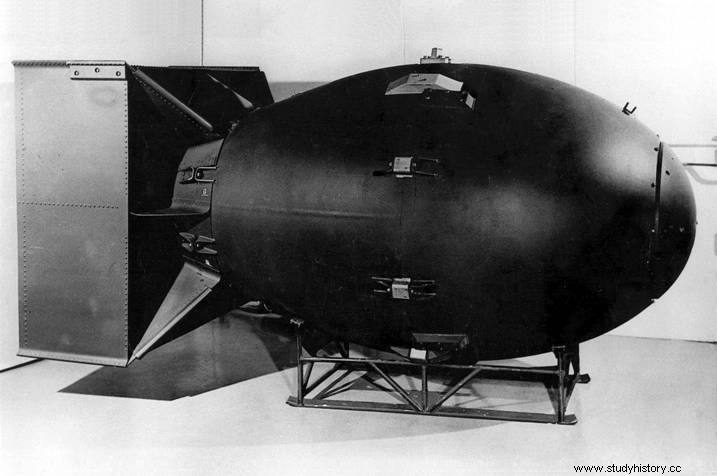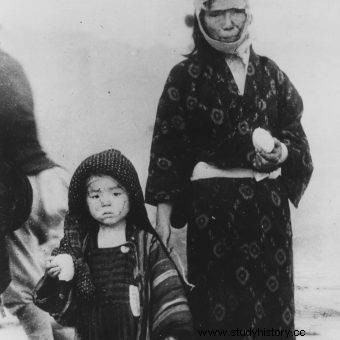“Some had burned eyebrows, and the skin was hanging from their faces and hands. Others raised their arms in pain (…). Still others were walking and vomiting, ”described the victims of nuclear attacks on Japan in 1946, the American journalist John Hersey. The number of killed and wounded was in the tens of thousands. How many exactly were there?
The Americans conducted a successful nuclear test on July 16. Nine days later, the order was given to drop the first special bomb around August 3, "as soon as the weather permits observation of it being dropped on one of the following targets:Hiroshima, Kokura, Niigata and Na-gasaki." The army has been authorized to deploy more bombs as they become available.
The Five Hundred and Ninth Mixed Group led by Captain Paul Tibbets, a veteran of the US bombing campaign in Europe, has been specially trained for the nuclear bomb drop procedure. In June, the group moved to Tinian Island, where the largest air base in the world was located at that time.
Little boy, big disaster
In early August, they were joined by the uranium bomb, with false modesty dubbed "Little Boy", and the platoon bomb "Fat Man". On Saturday, August 4, Tibbets briefed his troops. "The moment has come," he announced. - We've all been working on it. The weapon we will use now has just been successfully tried in the United States. We have received an order to drop her on the enemy. ”
"This one bomb," he added, " is the most devastating weapon ever produced . We believe it will annihilate everything within five kilometers. " The soldiers listened to this "with amazement in disbelief."
The next day, Tibbets demanded that his plane be named after his mother - "Enola Gay". That evening the crew received a blessing at the service for Catholics at ten o'clock and for Protestants at ten-thirty. One flyer was to ask for forgiveness of sins.
On Monday, August 6, 1945, the Enola Gay took off for the twelve-hour flight over Hiroshima and back. At 8.15am Hiroshima time, the Little Boy bomb exploded with a blinding flash six hundred meters above the city center. A cloud of radioactive dust in the shape of a huge mushroom rose about twelve kilometers into the sky.

The crew of the (incomplete) B-29 Superfortress "Enola Gay" bomber that dropped the "Little Boy".
Tibbets said to his soldiers, "Colleagues, you just dropped the first atomic bomb in history." Robert Lewis, Tibbets' co-pilot, was taking notes during the flight. He wrote:"My God, what have we done?" . President Truman heard about this as he flew over the Atlantic on his way back from his meeting with Stalin in Potsdam. He immediately made a statement:
Sixteen hours ago, an American plane dropped a bomb on Hiroshima, an important Japanese army base. This bomb had the power of over 20,000 tons of TNT […]. This power from which the energy of the sun comes was used against those who started the war in the Far East.
[…] We will destroy their ports, their factories, and their connectivity. Let there be no doubts […]. If they don't agree to our terms now, can expect a rain of destruction from the skies that no one has ever seen on earth […].
Tragic lawlessness
Since they were given a free hand, US commanders did not consult politicians before the "Fat Man" platoon bomb was dropped on Nagasaki on August 9. Following Truman's statement, there were several unpleasant reports in the press about the "groans, whining and complaining" of the Japanese, who for all their atrocities during the war and their deceit at Pearl Harbor got what they deserved.
But also many Americans predicted that their terrible weapons would be directed against themselves . On the same day, the evening news of NBC Radio stated:"We must assume that soon the improved version of the new weapon we are using today will be used against us." (…) The outraged reader of Time magazine wrote:
The United States of America that day became the new champion of cruelty, wickedness and monstrosity […]. No peaceful application of this Frankenstein monster will ever erase the crime we committed.
(…) In the beginning, there was very little specific information from Japanese cities. Japanese radio reported that "the impact force of the bomb was so terrible that virtually all living things, humans and animals, were literally incinerated as a result of the enormous temperature and pressure caused by the explosion."

The "Fat Man" bomb that destroyed Nagasaki.
The bomb exploded directly above a hospital in the city center. She killed all patients, doctors and nurses, and all teachers and students at a nearby school. In the nearby garrison, three thousand soldiers died during the morning roll call.
Teams from outside started reaching the site, first Japanese, then American, British and Russian. It turned out that the explosion and fire destroyed almost thirteen square kilometers of the city. One concrete building at the zero point of explosion remained almost intact, the others were badly damaged.
Within a kilometer and a half, brick buildings were completely destroyed, while wooden buildings, which were the most, were literally wiped off the face of the earth.
Count uncountable
American scientists measured human shadows burned on buildings and on the ground by the flash of a bomb. Using a mathematical formula called "normalized number of victims", they estimated that the bomb killed or injured people six and a half thousand times more efficiently per pound of explosive force used than with a conventional bomb.
After several decades, it was still impossible to determine the final number of victims - killed and injured as a result of the initial flare-up and explosion, fire, irradiation, radioactive fallout and the resulting cancer cases. The first reports from Japan said that cadavers "were too many to count".
In the very beginning, at least 70-80,000 people were killed in Hiroshima and 35-40,000 in Nagasaki . In late August, the death toll began to rise again as the effects of irradiation became apparent. Certainty on this point has never been achieved.

Many who survived the attack later died in agony from radiation sickness and cancer (in the photo, a woman and a child, the day after the Nagasaki bombing).
It took some time before the voice of the survivors became audible - hibakusha, as the people affected by the bomb blast in Hiroshima or Nagasaki were called. The survivors did not want to talk about their experiences, and the others did not want to hear about them. Initially, the US occupation forces censored journalists' reports on the subject.
The first comprehensive report by a veteran among John Hersey's reporters appeared in August 1946 in The New Yorker. And it immediately entered the classics of journalism. (...) Hersey's report vanished from the kiosks within hours. It has been read in full by radio, distributed free of charge by the Book of the Month Club, and published as a book in the US and UK. It is still on sale after seventy years.
Source:
The above text is an excerpt from Rodric Braithwaite's book " Armageddon and Paranoia. Cold War - Nuclear Confrontation ” , published by the Znak Horyzont publishing house.
